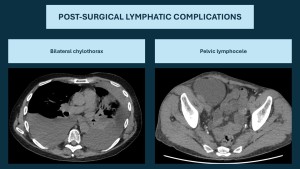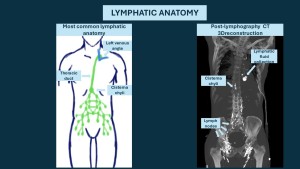The lymphatic system plays a fundamental role in the human body, regulating extracellular fluid homeostasis, working with the immune system, (1) and help the delivery of nutrients transporting chylomicrons through the thoracic duct to the systemic circulation. (2)
The lymphatic system has gained also a relevant role in oncology, since tumor staging, treatment and prognosis are directly related to lymphatic involvement. (3)
Lymphadenectomies often play an important role in the treatment of resectable tumors. (3)
Both lymphadenectomies and en bloc resections can alter and cause damage to lymphatic drainage

The lymphatic system has a complex structure, it can be divided into a peripheral and a central conducting system. Its anatomy can vary significantly and frequently. Not only both collecting channels and lymph nodes can vary in number and location, but even major structures. (4)

The main drainage station for intestinal lymphatic system is the cisterna chyli. Usually, it presents in the form of a saccular dilatation in the retroperitoneal space, near the abdominal aorta. Other times it can also appears as a complex system of anastomosis, with multiple convergent ducts.(3)
Cisterna chyli can be seen only in 52% of lymphangiography studies and 20% of autopsy studies. (4)
Chylous drainage continues in the cephalic direction to the thoracic duct.
The thoracic duct is the longest lymphatic duct in the body, it originates from the cisterna chyli, and rise through the aortic hiatus into the chest, to drain into the great left veins of the neck.
There are five principal morphological variants described by Kausel et al. The thoracic duct can drain into the venous system in different sites, the most common site is the left jugular vein (46%) (5).
Imaging of the lymphatic system can be used to detect chylous leaks, identifying site of lymphatic obstruction, and abnormal lympho-lymphatic, or lymphovenous connections.
Multiple imaging techniques can be used to study the lymphatic system.
While lymphoscintigraphy is used for the imaging of the extremity, MRI lymphangiography is fast and safe option, but it does not allow to perform therapeutic procedures.
Lymphography is an interventional radiology imaging technique that remains the gold standard to visualize the lymphatic system and diagnose disorders. Recent advancements in lymphatic imaging have enhanced its role in both diagnostic and therapeutic interventions. Interventional radiologists play a key part in managing these conditions using lymphography as a guide for procedures such as thoracic duct and lymphatic leaks embolization.